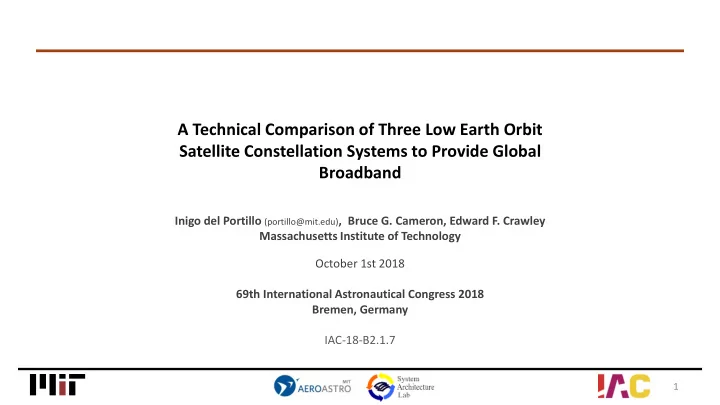

A Technical Comparison of Three Low Earth Orbit Satellite Constellation Systems to Provide Global Broadband Inigo del Portillo (portillo@mit.edu) , Bruce G. Cameron, Edward F. Crawley Massachusetts Institute of Technology October 1st 2018 69th International Astronautical Congress 2018 Bremen, Germany IAC-18-B2.1.7 1
• In the last 3 years there has been a new wave of proposals of LEO mega-constellations to provide broadband . (11 proposals) • This paper compares the technical aspects of three of these systems as described in their FCC Motivation application filings: • OneWeb , SpaceX , and Telesat • Moreover, we analyze ground segment requirements and estimate the total system forward capacity (sellable capacity) for each of the systems. 2
Description: OneWeb’s Ku&Ka-band System System characteristics • 720 satellites in 18 polar planes at 1,200 km @ 86.4º (40 satellites per plane) • User links @ Ku-band, gateway links @Ka-band • Bent pipe architecture • No crosslinks • Compact satellites 145 kg. • Target first launch Q4’18, Q1’19 (21 Soyuz rockets) • Beginning of service 2019 Figure 1.- OneWeb 720 satellites constellation Image credit: OneWeb 3 Description Comparison Methodology Results Conclusions
Description: SpaceX’s Ku&Ka-band System System characteristics • 4,425 Satellites in 83 planes. Inclined orbits + polar orbits. • User links @ Ku-band, gateway links @Ka-band • Optical crosslinks between satellites • Digital payload with beam steering and shaping capabilities • Medium size satellites 386 kg, in house designed. • Target first launch 2019 (~170 Falcon 9 launches for full constellation deployment) • Beginning of service 2020 Figure 2.- SpaceX 4,425 satellites constellation Image credit: SpaceX 4 Description Comparison Methodology Results Conclusions
Description: Telesat’s Ka-band System System characteristics • 117 Satellites in 11 planes: Polar: 6 planes x 12 satellites at 1,000 km @ 99.5º Inclined: 5 planes x 9 satellites at 1,200 km @ 37.4 • User and gateway links @Ka-band • Optical crosslinks between satellites • Digital payload: Beamforming: steering and shaping capabilities for at least 16 beams. Demodulation + modulation + IP-Routing • Launch 2021 • Beginning of service 2022 • External design and manufacturing. Figure 3.- Telesat 117 satellites constellation 5 Description Comparison Methodology Results Conclusions
Satellites in line of sight and beam characteristics • Great differences in the number of satellites within line of sight for different latitudes between constellations. • Telesat and SpaceX concentrate their satellites within the ±60 latitude band by using inclined and polar orbits. • Significant differences in beam footprint and field-of-view areas. • SpaceX and Telesat have steerable and shapeable user beams. One web has fixed beams. 6 Description Comparison Methodology Results Conclusions
Frequency allocations • OneWeb and SpaceX use Ku-band for user links. Single polarization, RHCP, and Ka-band for gateway links. • Telesat shares the Ka-band spectrum between user and gateways links. • Potential interferences during in-line events between: OneWeb and SpaceX user links. Telesat user links and OneWeb and SpaceX feeder links Key OneWeb SpaceX Telesat Downlinks Uplinks Gateway-links Gateway-links Gateway-links User-links User-links User-links GSO Geostationary satellite orbit TT&C-links TT&C-links TT&C-links Terrestrial fixed service TFS Fixed satellite service Mobile satellite service feeder links FSS MSS FL MSS Mobile satellite service Local multipoint distribution service LMDS Broadcast satellite service Non-geostationary satellite orbit BSS NGSO 7 Description Comparison Methodology Results Conclusions
Methodology: Model overview Table 8. Average and maximum potential data-rate Atmospheric per satellite (author’s estimation) models ITU Total throughput Parameter Telesat OneWeb SpaceX estimation Avg. Data-rate 35.65 8.80 20.12 Gbps Link Link Budget Max. Data-rate 38.68 9.97 21.36 Gbps parameters Statistical # Active GW antennas 2 1 1 - model GW User GW Constellation Orbital Limiting factor - uplink downlink uplink orbital info. Dynamics Ground segment Candidate optimization GS locations Optimal ground Genetic segment Demand map Algorithm 8 Description Comparison Methodology Results Conclusions
Results: Throughput estimation Telesat SpaceX Telesat: • Maximum throughput is 2.66 Tbps and 42 ground stations are required to achieve it. SpaceX: • Maximum throughput of 23.7 Tbps with > 100 GS. OneWeb OneWeb + ISL OneWeb • Maximum throughput is 1.56 Tbps, and need 71 ground station to achieve it. 9 Description Comparison Methodology Results Conclusions
Results: S ummary of values Telesat OneWeb SpaceX Telesat: Num. satellites 117 720 4,425 - • Telesat is the most efficient system in Max. total system FWD 2.66 1.56 23.7 Tbps terms of average Gbps/satellite, with more capacity Number of ground than 4x SpaceX and 10x OneWeb. locations for max. FWD 42 71 123 - capacity SpaceX: Number of gateway • SpaceX limiting factor will be the ground antennas for max FWD 221 725 ~3,500 - capacity segment, as they need to deploy a very Required number of large number of ground stations and gateways per ground 5-6 11 30 - station gateways to operate at full power. Average data-rate per 22.74 2.17 5.36 Gbps satellite (real) OneWeb Max. data-rate per 38.68 9.97 21.36 Gbps • For OneWeb the space segment will be satellite Satellite efficiency 58.8 21.7 25.1 % the limiting factor (user links data-rate). 10 Description Comparison Methodology Results Conclusions
Conclusions • Estimated maximum system throughputs in the forward direction: OneWeb’s 1.56 Tbps with 71 ground stations (720 satellites) Telesat 2.66 Tbps with 40 ground stations (117 satellites) SpaceX 23.7 Tbps with 123 ground stations (4,425 satellites) • The most effective system in terms of Gbps/satellite is Telesat (22.7 Gbps/sat), thanks to: Low number of high capacity satellites, low elevation angles to user links, use of ISL and digital payloads, and use of two active gateway antennas. • SpaceX constellation will require an extremely large ground segment with hundreds of ground stations and ~3,500 gateway antennas to operate at maximum throughput. • OneWeb’s constellation could significantly reduce their ground segment if they had used inter-satellite links (even at moderate data-rates ~5 Gbps). 11 Description Comparison Methodology Results Conclusions
THANK YOU! Contact e-mail: portillo@mit.edu
Recommend
More recommend